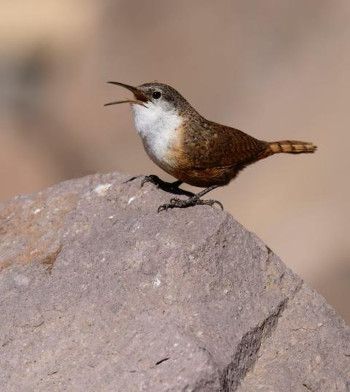Canyon Song
George Orwell had it right in Animal Farm, at least with respect to birds. Some birds are more equal than others, and it’s easily proved by a trip into a rock-strewn ravine inhabited by a canyon wren. Size makes no difference. Canyon wrens are small. But the voice? Oh, the voice is spellbinding, the song a gorgeously operatic, liquid series of descending notes that echo off the steep walls around you stopping you in your tracks. Here is song from what seems the heart of the world.

And then the bird comes into view, hopping out from behind a boulder to perch and sing again. It is a beauty, too. The canyon wren is like other wrens, thin-billed for probing crevices for food, diminutive for scooting in and out of tight places, and generally brown-backed with fine streaks and dark bars to give a bit of camouflage. But there the similarity ends, for the canyon wren is exquisitely colored, with pure white breast and cinnamon under parts that ignite the rich browns of back and tail. Here is beauty to match the song.
Canyon wrens are found where there is water, but these birds do not drink, getting the liquid they need from the food they eat, primarily insects and other arthropods gleaned from their habitat. The canyon wren’s head is flattened over the top, augmenting the probing utility of the long, somewhat decurved bill so that the bird can reach deep into crevices between rocks or in canyon walls to extract hidden prey.
Canyon wrens are rare away from their preferred canyon habitat. They are not migratory, but those that live at high elevations may move down mountain in colder months. Rock wrens, which are widespread residents of rocky places may occasionally be found where canyon wrens live, but in that somewhat more humid canyon-riparian environment may not be able to compete well with the canyon wrens that live there and seem so perfectly adapted to it. It is a life worth singing about, and the song is magnificent.


